Use of Modified Activated Carbon in Groundwater Remediation for Human Consumption
Abstract
1. Introduction
2. Materials and Methods
2.1. Adsorbent Preparation
2.2. Study Variables and Data Processing
2.3. Adsorption Capacity
2.3.1. Iodine Solution
2.3.2. Solution of Methylene Blue
2.4. Morphological Characterization of the Adsorbent
3. Results and Discussion
3.1. Carbonization
3.2. Activation
3.3. Adsorption
3.3.1. Adsorption in Iodine Solution (IS) and Methylene Blue Solution (MBS)
3.3.2. Adsorption Isotherms
3.4. Characterization of Adsorbents
3.4.1. Laser Scattering
3.4.2. Analysis by Scanning Electron Microscopy (SEM)
3.4.3. Analysis by Atomic Force Microscopy (AFM)
4. Conclusions
- The optimal conditions for improving carbonization performance in a tube furnace were a particle size of 126–250 µm and a carbonization temperature of 600 °C for 2 h. In a muffle furnace, the best results were achieved with 0–125 µm particles at 600 °C for 2 h.
- For activation, the ideal conditions in a tube furnace involve an initial particle size of 126–250 µm, carbonized at 500 °C for 2 h, and activated at 500 °C for 2 h. In the muffle furnace, the optimal conditions were the same particle size, carbonized at 600 °C for 3 h, and activated at 600 °C for 1 h.
- Samples prepared in both tube and muffle furnaces showed similar gas adsorption characteristics. However, the AC produced via artisanal methods exhibited significantly higher nitrogen adsorption capacity.
- Increasing the carbonization temperature in tube furnaces enhances iodine adsorption, while in muffle furnaces, higher activation temperatures tend to reduce iodine adsorption.
- In the tube furnace, increasing the rice husk particle size may slightly decrease the adsorption capacity for MBS and other organic pollutants. Conversely, in the muffle furnace, lower activation temperatures enhanced methylene blue adsorption.
Author Contributions
Funding
Data Availability Statement
Acknowledgments
Conflicts of Interest
References
- Edokpayi, J.; Enitan, A.; Mutileni, N.; Odiyo, J. Water quality assessment and human risk assessment due to heavy metals in groundwater around the Muledane area of Vhembe District, Limpopo Province, South Africa. Chem. Control Mag. 2018, 12, 2. [Google Scholar] [CrossRef] [PubMed]
- Díaz, B.; Sommer-Marquez, A.O.P.E.; Gonzalez, E.B.; Ricaurte, M.; Navas, C.C. Synthesis methods, properties and modifications of biochar-based materials for wastewater treatment: A review. Resources 2024, 13, 8. [Google Scholar] [CrossRef]
- Ahmad, H.A.; Ahmad, S.; Cui, Q.; Wang, Z.; Wei, H.; Chen, X.; Ni, S.Q.; Ismail, S.; Awad, H.M.; Tawfik, A. The environmental distribution and removal of emerging pollutants, highlighting the importance of using microbes as a potential degrader: A review. Sci. Total Environ. 2022, 809, 151926. [Google Scholar] [CrossRef]
- Hannah, D.M.; Abbott, B.; Khamis, K.; Kelleher, C.; Lynch, I.; Krause, S.; Ward, A.S. Illuminating the “invisible water crisis” to address global water pollution challenges. Hydrol. Process. 2022, 36, e14525. [Google Scholar] [CrossRef]
- Babatunde, E.O.; Gurav, R.; Hwang, S.C.S. Pistia stratiotes L. Biochar for sorption removal of aqueous inorganic nitrogen. Materials 2024, 17, 3858. [Google Scholar] [CrossRef]
- Rehman, S.u.; De Castro, F.; Marini, P.; Aprile, A.; Benedetti, M.; Fanizzi, F.P. Vermibiocharcoal: A new approach to reduce the environmental impact of heavy metal contamination on agricultural land. Sustainability 2023, 15, 9380. [Google Scholar] [CrossRef]
- Jha, E.; Gaur, R.; Shahabuddin, S.; Tyagi, I. Biochar as a sustainable alternative and environmentally friendly adsorbent for the remediation of harmful pollutants: A comprehensive review. Toxics 2023, 2, 117. [Google Scholar] [CrossRef]
- Présiga-López, D.; Rubio-Clemente, A.; Pérez, J. Use of biochar as an alternative material for the treatment of polluted wastewater. Rev. UIS Ing. 2020, 20, 121–134. [Google Scholar] [CrossRef]
- Imessaoudene, A.; Cheikh, S.; Bollinger, J.-C.; Belkhiri, L.; Tiri, A.; Bouzaza, A.; El Jery, A.; Assadi, A.; Amrane, A.; Mouni, L. Zeolite Waste Characterization and Use as Low-Cost, Ecofriendly, and Sustainable Material for Malachite Green and Methylene Blue Dyes Removal: Box–Behnken Design, Kinetics, and Thermodynamics. Appl. Sci. 2022, 12, 7587. [Google Scholar] [CrossRef]
- Jagadeesh, N.; de Baranidharan, S. Adsorption of wastewater pollutants by biochar: A review. Hazard. Mater. Adv. Mag. 2023, 9, 100226. [Google Scholar] [CrossRef]
- Iamsaard, K.; Weng, C.H.; Yen, L.; Tzeng, J.H.; Poonpakdee, C.; Lin, Y.T. Aadsorption of metals in pineapple leaf biochar: Key factors affecting, identification of mechanisms and assessment of regeneration. Bioresour. Technol. 2021, 344, 126131. [Google Scholar] [CrossRef]
- Zhang, M.; Song, G.; Gelardi, D.L.; Huang, L.; Khan, E.; Mašek, O.; Parikh, S.J.; Ok, Y.S. Evaluation of biochar and its modifications for ammonium, nitrate and phosphate removal from water. Water Res. 2020, 186, 116303. [Google Scholar] [CrossRef]
- Guixiang, Z.; Zhihua, Z.; Zhu, Y. Changes in abiotic dissipation rates and bound fractions of antibiotics in biochar-amended soils. J. Clean. Prod. 2020, 256, 120314. [Google Scholar] [CrossRef]
- Fu, M.M.; Mo, C.H.; Hui, L.; Zhang, Y.N.H.W.X.; Wong, M.H. Comparación de las propiedades fisicoquímicas de los biochars e hidrochars producidos a partir de residuos alimentarios. Rev. Prod. Más Limpia 2019, 236, 2117637. [Google Scholar] [CrossRef]
- Huang, L.; Gu, M. Effects of biochar on container substrate properties and growth of plants—A review. Horticulturae 2019, 5, 2–25. [Google Scholar] [CrossRef]
- Velázquez-Maldonado, J.; Juárez-López, P.; Anzaldo-Hernández, J.; Alejo-Santiago, G.; Valdez-Aguilar, L.A.; Alia Tejacal, I.; López-Martínez, V.; Pérez Arias, G.A.; Guillén Sánchez, D. Concentración nutrimental de biocarbón de cascarilla de arroz. Rev. Fitotec. Mex. 2019, 42, 129–136. [Google Scholar]
- Viotti, P.; Marzeddu, S.; Antonucci, A.; Décima, M.A.; Lovascio, P.; Tatti, F.; Boni, M.R. Biochar as an alternative material for the adsorption of heavy metals from groundwater: Review of a laboratory-scale experiment (column). Materials 2023, 17, 809. [Google Scholar] [CrossRef]
- Dong, M.; He, L.; Jiang, M.; Zhu, Y.; Wang, J.; Gustave, W.; Wang, S.; Deng, Y.; Zhang, X.; Wang, Z. Biochar for the Removal of Emerging Pollutants from Aquatic Systems: A Review. Int. J. Environ. Res. Public Health 2023, 20, 1679. [Google Scholar] [CrossRef] [PubMed]
- Zama, E.; Li, G.; Tang, Y.T.; Reid, B.; Ngwabie, N.; Sun, G.X. The removal of arsenic from solution through biochar-enhanced precipitation of calcium-arsenic derivatives. Environ. Pollut. 2022, 292, 118241. [Google Scholar] [CrossRef] [PubMed]
- Amen, R.; Bashir, H.; Bibi, I.; Shaheen, S.; Niazi, N.; Shahid, M.; Hussain, M.M.; Antoniadis, V.; Shakoor, M.B.; Al-Solaimani, S.G.; et al. A critical review on arsenic removal from water using biochar-based sorbents: The importance of modification and redox reactions. Chem. Eng. J. 2020, 396, 125195. [Google Scholar] [CrossRef]
- Wang, C.; Wang, X.; Li, N.; Tao, J.; Yan, B.; Cui, X.; Chen, G. Adsorption of lead from aqueous solution by biochar: A review. Clean Tecnol. 2022, 4, 629–652. [Google Scholar] [CrossRef]
- Ndoun, M.; Elliott, H.; Preisendanz, H.; Williams, C.; Knopf, A.; Watson, J. Adsorption of pharmaceuticals from aqueous solutions using biochar derived from cotton gin waste and guayule bagasse. Biochar 2021, 3, 89–104. [Google Scholar] [CrossRef]
- Janu, R.; Mrlik, V.; Ribitsch, D.; Hofman, J.; Sedláček, P.; Bielská, L.; Soja, G. Biochar surface functional groups as affected by biomass feedstock, biochar composition and pyrolysis temperature. Carbon Resour. Convers. 2021, 4, 36–46. [Google Scholar] [CrossRef]
- Li, Z.; Zheng, Z.; Li, H.; Xu, D.; Li, X.; Xiang, L.; Tu, S. Review of rice husk biochar as an adsorbent for soil and water remediation. Plants 2023, 12, 1524. [Google Scholar] [CrossRef] [PubMed]
- Andalia, R.; Rahmi, R.; Julinawati, J.; Helwati, H. Isolation and characterization of cellulose from rice husk and sawdust waste with chemical method. Rev. Nat. 2020, 20, 6–9. [Google Scholar] [CrossRef]
- ASTM. Standard Test Method for Determination of Iodine Number of Activated Carbon. 1999. Available online: https://cdn.standards.iteh.ai/samples/5745/e8253cc9a5ce4881916e4858e81f0bfa/ASTM-D4607-94-1999-.pdf (accessed on 1 December 2024).
- Asimbaya, C.; Rosas, N.; Endara, D.; Guerrero, V.H. Obtención de carbón activado a partir de residuos lignocelulósicos de canelo, laurel y eucalipto. Rev. Politécnica 2015, 36, 24–29. [Google Scholar]
- Kambo, H.S.; Dutta, A. A comparative review of biochar and hydrochar in terms of production, physico-chemical properties and applications. Renew. Sustain. Energy Rev. 2015, 45, 369–378. [Google Scholar] [CrossRef]
- Varón Camargo, J. Diseño, construcción y puesta a punto de un prototipo de quemador para la combustión continua y eficiente de la cascarilla de arroz. El Hombre Y Máquina 2005, 25, 128–135. [Google Scholar]
- Valverde, A.; Sarria, B.; Monteagudo, J.P. Análisis comparativo de las características fisicoquímicas de la cascarilla de arroz. Sci. Tech. 2007, 13, 255–260. [Google Scholar]
- Kalderis, D.K.M.S.; Méndez, A.; Gascó, G. Characterization of hydrochars produced by hydrothermal carbonization of rice husk. Solid Earth 2014, 5, 477–483. [Google Scholar] [CrossRef]
- Cárdenas-Aguiar, E.; Méndez, A.; Gasco, G.; Lado, M.; Paz González, A. The Effects of Feedstock, Pyrolysis Temperature, and Residence Time onthe Properties and Uses of Biochar from Broom and Time onthe Properties and Uses of Biochar from Broom and Gorce Wastes. Appl. Sci. 2024, 14, 4283. [Google Scholar] [CrossRef]
- Medina González, C.D.; Manrique-Abril, R.A. Uso del Carbón Activado Para el Tratamiento de Aguas. Revisión y Estudios de Caso. Rev. Nac. Ing. 2018, 1, 1–15. Available online: https://agenf.org/ojs/index.php/RNI/article/view/269/264 (accessed on 3 April 2024).
- Palacios-Zambrano, J.J.; Vera-Vera, Ä.R.; Arce-Santqana, I.E.; Lucero-Älvarez, M.G.; Barzola-Miranda, S.E.; Gutierrez-Lara, V.E. Análisis fisioquímico de tres variedades de carbón activado de cascarilla de arroz. Ingeniar Ing. Tecnol. E Investig. 2024, 7, 213–226. [Google Scholar] [CrossRef]
- Robinson Ubau, D.B.; Torres Martínez, D.U.; Vílchez Pérez, H.J. Uso sostenible de la cascarilla de arroz para productos de valor añadido. El Higo Rev. Científica 2022, 12, 2–27. [Google Scholar] [CrossRef]
- Sánchez, K.; Giplberto, C.; Pire, M.; Díaz, A.; Carrasquero, S. Adsorption capacity of activated carbon on total chromium from tannery waste. Rev. Técnica Fac. De Ing. Univ. Del Zulia 2013, 36, 45–52. [Google Scholar]
- Efiyanti, I.; Indrawan, D.A.; Hastuti, N.; Darmawan, S. The activated carbon produced from mayan bamboo. IOP Conf. Ser. Mater. Sci. Eng. 2020, 935, 012018. [Google Scholar] [CrossRef]
- Hajam, M.E.; Kandri, N.I.; Harrach, A.; Khomsi, A.E.; Zerouale, A. Adsorption of Methylene Blue on industrial softwood waste “Cedar” and hardwood waste “Mahogany”: Comparative study. Mater. Today Proc. 2019, 13, 812–821. [Google Scholar] [CrossRef]
- Nunes, C.A.; Guerreiro, M.C. Estimación de la supericie y el volumen de poros de carbones activados utiizando azul de metileno y número de yodo. Int. Year Chem. 2011, 34, 472–476. [Google Scholar] [CrossRef]
- Ebadollahzadeh, H.; Zabihi, M. Competitive adsorption of methylene blue and Pb (II) ions on the nano-magnetic activated carbon and alumina. Mater. Chem. Phys. 2020, 248, 122893. [Google Scholar] [CrossRef]
- Osman, Ü. Hydrogen storage capacity and methylene blue adsorption performance of activated carbon produced from Arundo donax. Mater. Chem. Phys. 2019, 237, 121858. [Google Scholar] [CrossRef]
- Zhang, Z.; Zhu, Z.; Shen, B.; Liu, L. Perspectives on biochar and hydrocarbon production and applications: A review. Energy 2019, 171, 581–598. [Google Scholar] [CrossRef]
- Zhao, J.J.; Shen, X.J.; Domene, X.; Alcañiz, J.M.; Liao, X.; Palet, C. Comparison of biochars derived from different types of feedstocks and their potential for heavy metal removal in multi-metal solutions. Inf. Científicos 2019, 9, 9869. [Google Scholar] [CrossRef]
- Zhang, Y.; Xu, X.; Cao, L.; Ok, Y.S.; Cao, X. Characterization and quantification of electron donating capacity and its structure dependence in biochar derived from three waste biomasses. Chemosphere 2018, 211, 1073–1081. [Google Scholar] [CrossRef]
- Jing, F.; Pan, M.; Chen, J. Kinetic and isothermal adsorption-desorption of PAE on biochars: Effect of biomass feedstock, pyrolysis temperature and implication of desorption hysteresis mechanism. Pollut. Environ. Sci. Res. 2018, 25, 11493–11504. [Google Scholar] [CrossRef]
- Prieto García, J.O.; Curbelo Sánchez, A.; Albernas Carvajal, Y.; Rodríguez Suárez, E.; Ribalta Quezada, J.; Perez Leyva, A. Estudio de la adsorción de ácidos orgá¡nicos en ceniza de bagazo de caña de azúcar. Cent. Azúcar 2017, 44, 63–72. [Google Scholar]
- Qiu, M.; Liu, L.; Ling, Q.; Cai, Y.; Yu, S.; Wang, S.; Fu, D.; Hu, B.; Wang, X. Biochar for removal of contaminants from soil and water: A review. Biochar 2022, 4, 19. [Google Scholar] [CrossRef]
- Shrestha, L.K.; Thapa, M.; Shrestha, R.G.; Maji, S.; Pradhananga, R.R.; Ariga, K. Materiales de carbono nanoporosos de gran superficie derivados de cáscara de arroz con excelentes propiedades de adsorción de yodo y azul de metileno. Repos. Inst. CONICET Digit. 2019, 5, 10. [Google Scholar] [CrossRef]
- Canh, V.D.; Tabata, S.; Yamanoi, S.; Onaka, Y.; Yokoi, T.; Furumai, H.; Katayama, H. Evaluación de adsorbentes de carbono poroso hechos a partir de cáscaras de arroz para la eliminación de virus en agua. Water 2021, 13, 1280. [Google Scholar] [CrossRef]
- Carrillo Quijano, C.C.; Albarracín Caballero, J.; Pereira Hernández, X.I. Producción de carbón activado y sílice a partir de cascarilla de arroz—Una revisión. Sci. Tech. 2013, 18, 422–429. [Google Scholar]
- Kim, J.E.; Bhatia, S.K.; Song, H.J.; Yoo, E.; Jeon, H.J.; Yoon, J.Y.; Yang, Y.; Gurav, R.; Yang, Y.H.; Kim, H.J.; et al. Adsorptive removal of tetracycline from aqueous solution using maple leaf-derived biochar. Bioresour. Technol. 2020, 306, 123092. [Google Scholar] [CrossRef]
- Arcos, C.A.; Macíaz Pinto, D.; Rodríguez Páez, J.E. La cascarilla de arroz como fuente de SiO2. Rev. Fac. Ing. Univ. Antioq. 2007, 41, 7–20. Available online: http://www.redalyc.org/articulo.oa?id=43004102 (accessed on 1 December 2024).
- Zoommicroscopio. Microscopía de Fuerza Atómica en Materiales. 2023. Available online: https://zoommicroscopio.com/microscopia-de-fuerza-atomica-en-la-investigacion-de-materiales/ (accessed on 23 January 2024).
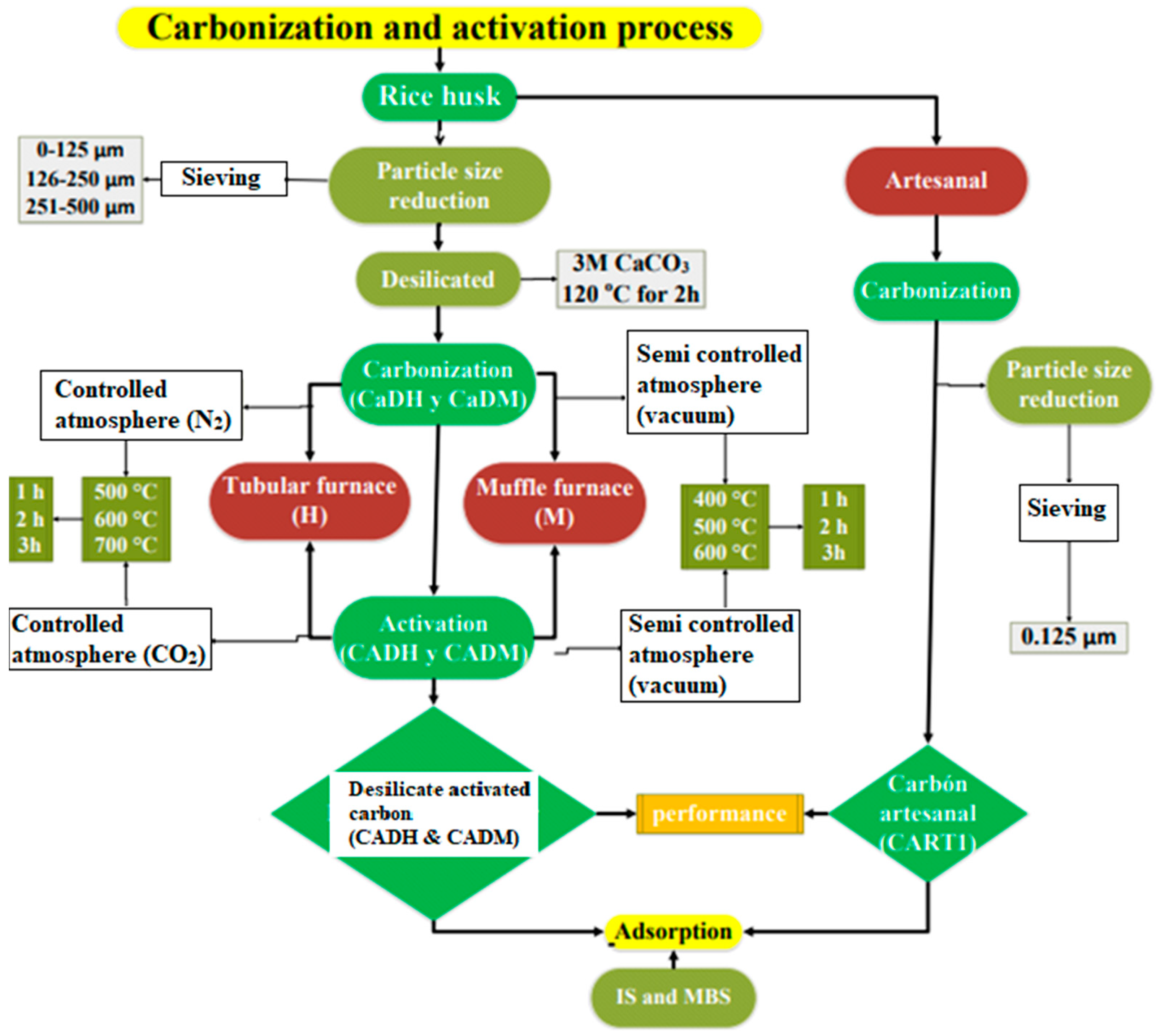

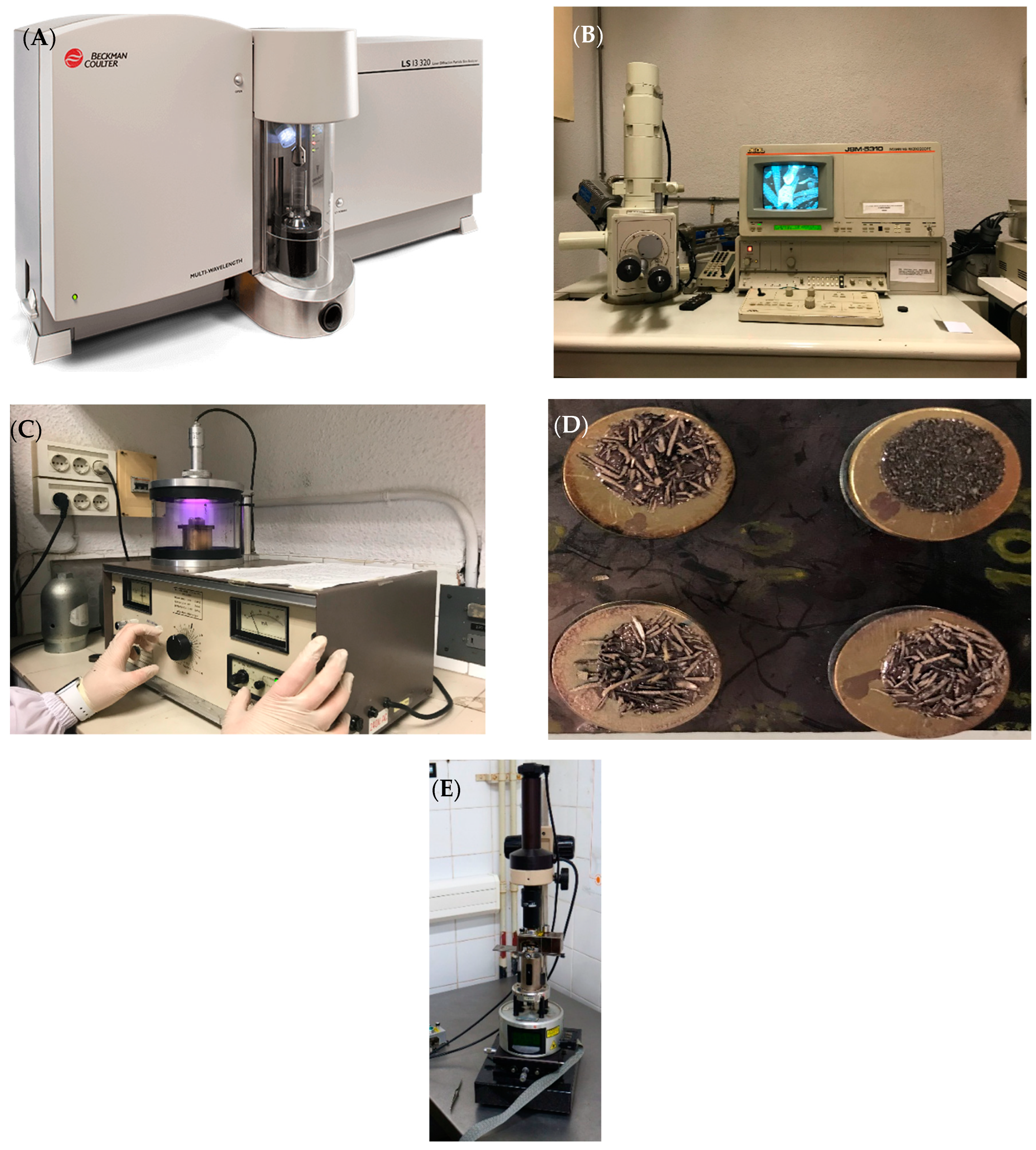
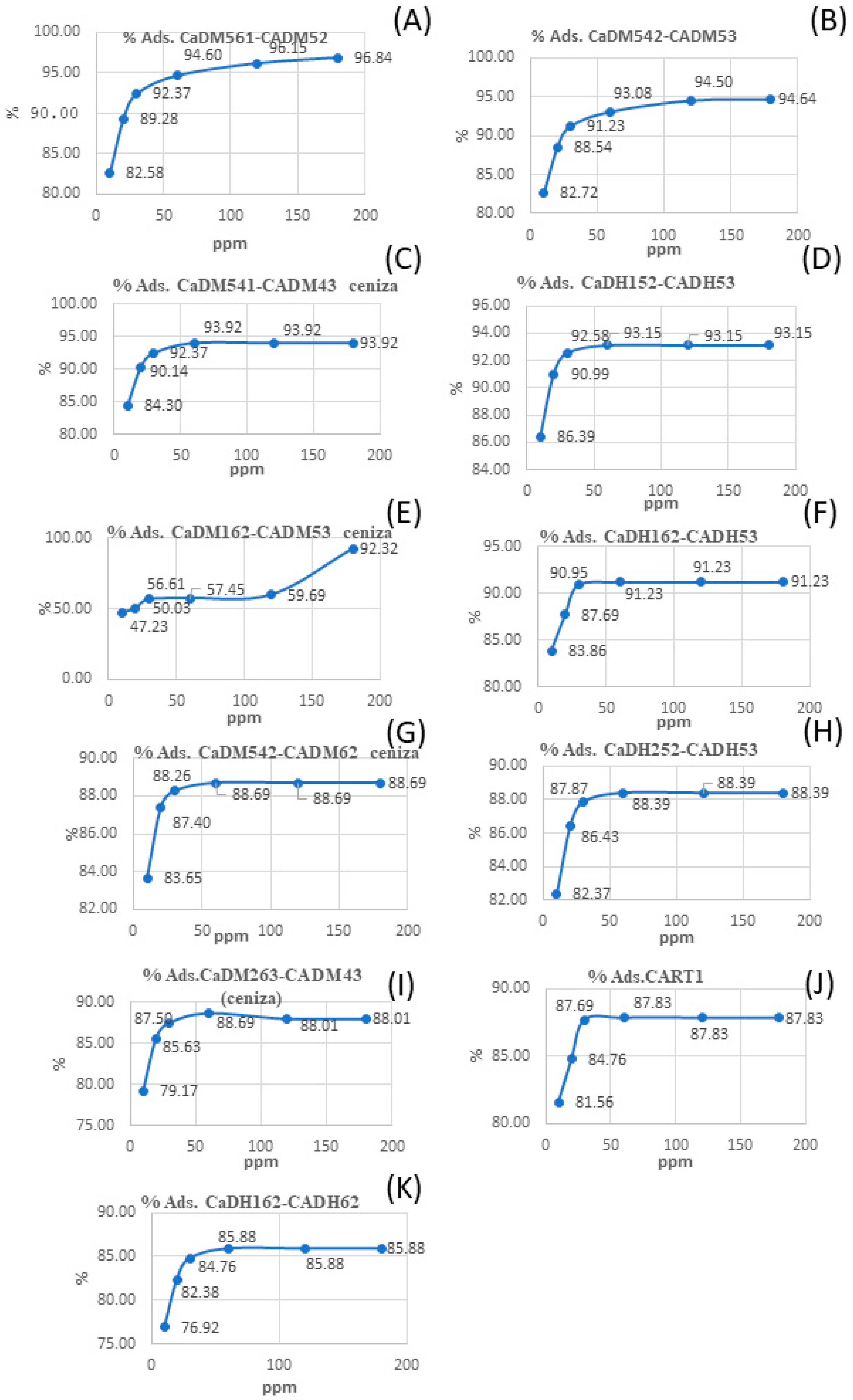
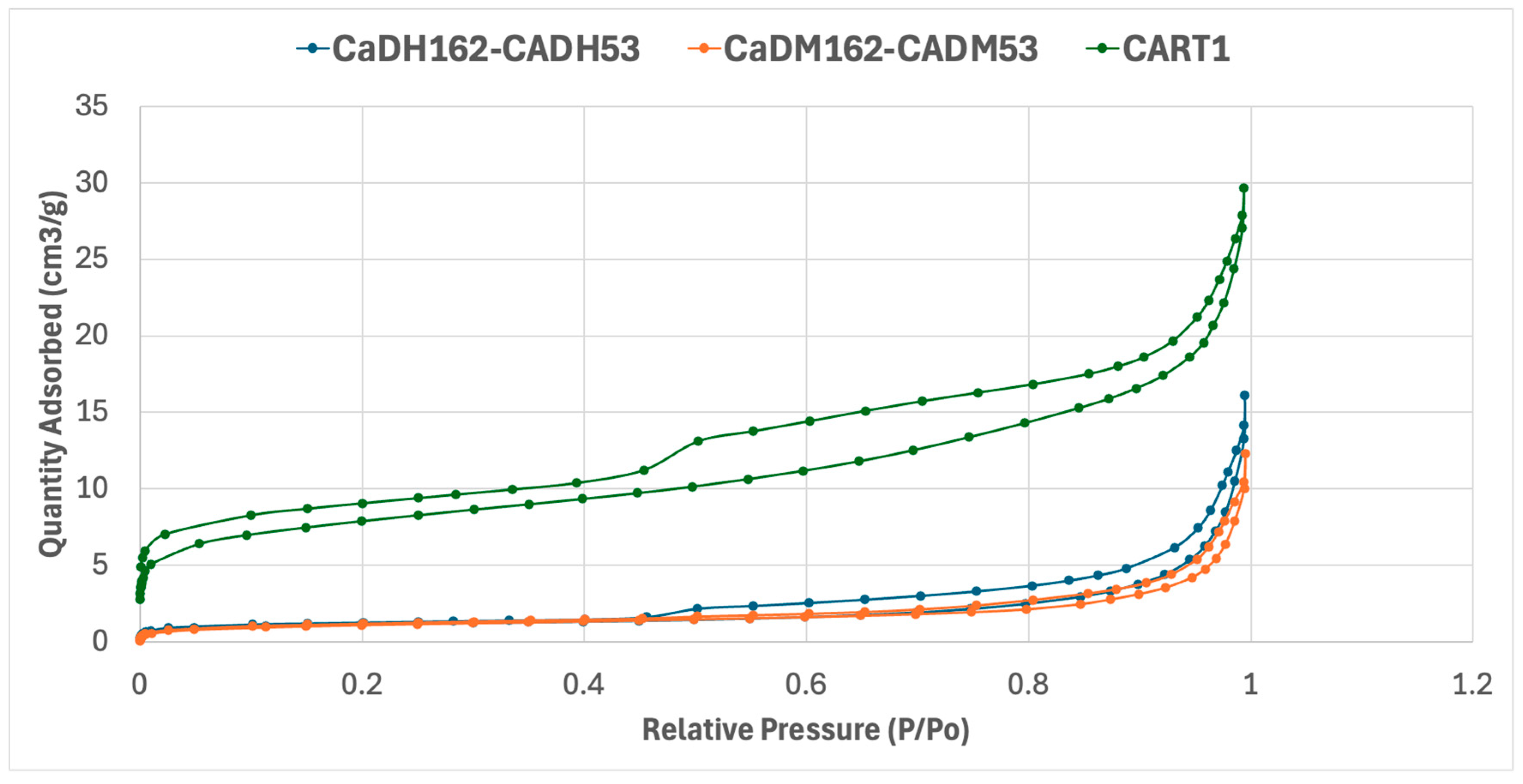
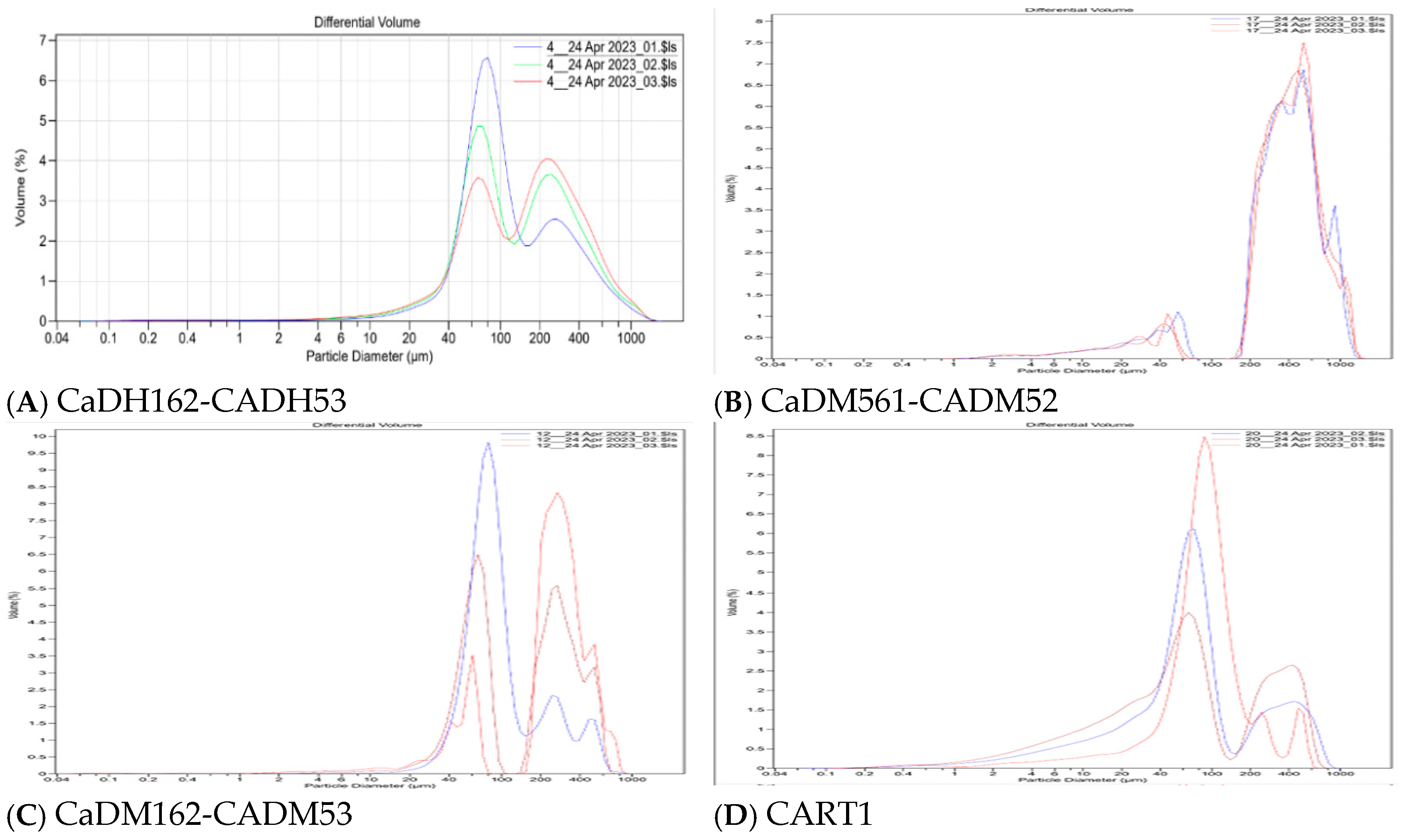
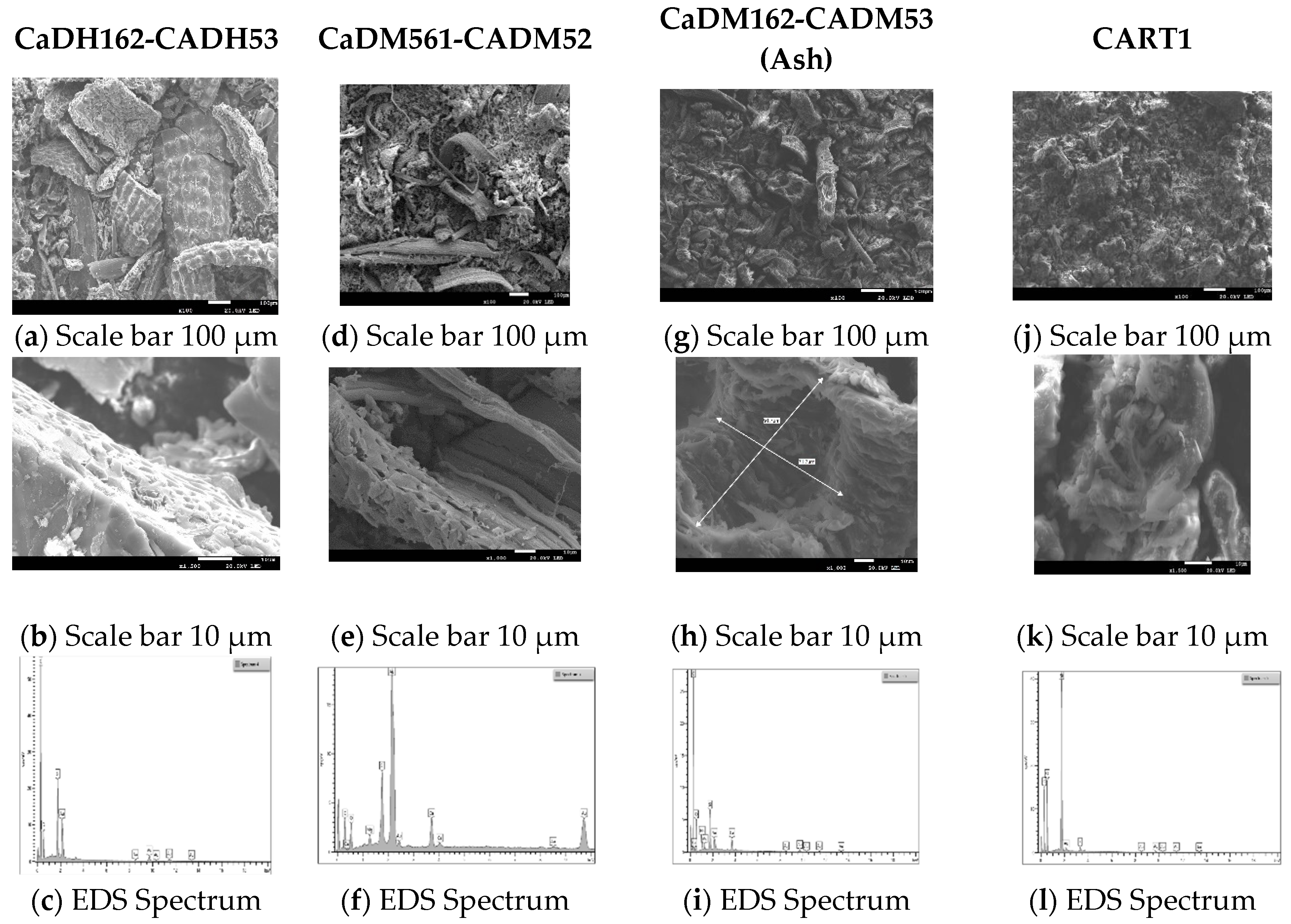

| Tube Furnace | Muffle Furnace | ||||||||||||
|---|---|---|---|---|---|---|---|---|---|---|---|---|---|
| ID | Particle Size (µm) | Temperature (°C) | Time (h) | Initial Weight (g) | Final Weight (g) | Yield (%) | ID | Particle Size (µm) | Temperature (°C) | Time (h) | Initial Weight (g) | Final Weight (g) | Yield (%) |
| CaDH151 | 0–125 | 500 | 1 | 31.1 | 18.1 | 58.1 | CaDM141 | 0–125 | 400 | 1 | 5.2 | 2.5 | 48.0 |
| CaDH152 | 0–125 | 500 | 2 | 14.6 | 10.4 | 71.4 | CaDM142 | 0–125 | 400 | 2 | 3.3 | 2.3 | 72.2 |
| CaDH153 | 0–125 | 500 | 3 | 47.6 | 22.0 | 46.2 | CaDM143 | 0–125 | 400 | 3 | 7.5 | 4.6 | 61.1 |
| CaDH161 | 0–125 | 600 | 1 | 40.4 | 23.1 | 57.3 | CaDM151 | 0–125 | 500 | 1 | 6.2 | 3.7 | 59.7 |
| CaDH162 | 0–125 | 600 | 2 | 38.2 | 24.7 | 64.8 | CaDM152 | 0–125 | 500 | 2 | 5.1 | 3.0 | 59.0 |
| CaDh163 | 0–125 | 600 | 3 | 24.0 | 15.0 | 62.7 | CaDM153 | 0–125 | 500 | 3 | 5.0 | 3.0 | 59.4 |
| CaDH171 | 0–125 | 700 | 1 | 40.7 | 13.7 | 33.7 | CaDM161 | 0–125 | 600 | 1 | 4.3 | 2.6 | 59.8 |
| CaDH172 | 0–125 | 700 | 2 | 36.6 | 17.6 | 48.1 | CaDM162 | 0–125 | 600 | 2 | 2.8 | 2.7 | 92.8 |
| CaDH173 | 0–125 | 700 | 3 | 40.9 | 15.6 | 38.1 | CaDM163 | 0–125 | 600 | 3 | 2.9 | 1.7 | 59.3 |
| CaDH251 | 126–250 | 500 | 1 | 30.0 | 12.3 | 41.1 | CaDM241 | 126–250 | 400 | 1 | 3.5 | 2.1 | 59.5 |
| CaDH252 | 126–250 | 500 | 2 | 20.8 | 13.9 | 66.6 | CaDM242 | 126–250 | 400 | 2 | 3.5 | 2.1 | 59.9 |
| CaDH253 | 126–250 | 500 | 3 | 31.8 | 11.2 | 35.4 | CaDM243 | 126–250 | 400 | 3 | 4.6 | 2.2 | 47.6 |
| CaDH261 | 126–250 | 600 | 1 | 22.0 | 9.6 | 43.8 | CaDM245 | 126–250 | 500 | 1 | 4.2 | 2.4 | 58.3 |
| CaDH262 | 126–250 | 600 | 2 | 26.5 | 19.0 | 71.7 | CaDM562 | 126–250 | 500 | 2 | 3.9 | 2.3 | 59.2 |
| CaDH263 | 126–250 | 600 | 3 | 25.5 | 10.6 | 41.5 | CaDM253 | 126–250 | 500 | 3 | 3.0 | 1.8 | 59.9 |
| CaDH271 | 126–250 | 700 | 1 | 24.0 | 10.0 | 41.6 | CaDM261 | 126–250 | 600 | 1 | 4.7 | 2.8 | 59.7 |
| CaDH272 | 126–250 | 700 | 2 | 23.8 | 16.01 | 67.5 | CaDM262 | 126–250 | 600 | 2 | 4.0 | 2.4 | 60.5 |
| CaDH273 | 126–250 | 700 | 3 | 55.2 | 14.1 | 25.6 | CaDM263 | 126–250 | 600 | 3 | 2.4 | 2.1 | 90.4 |
| CaDH551 | 256–500 | 500 | 1 | 25.6 | 9.8 | 38.4 | CaDM541 | 256–500 | 400 | 1 | 1.7 | 1.3 | 79.6 |
| CaDH552 | 256–500 | 500 | 2 | 25.9 | 15.5 | 59.7 | CaDM542 | 256–500 | 400 | 2 | 2.3 | 2.0 | 88.4 |
| CaDH553 | 256–500 | 500 | 3 | 27.0 | 9.4 | 34.7 | CaDM543 | 256–500 | 400 | 3 | 6.8 | 3.9 | 57.7 |
| CaDH561 | 256–500 | 600 | 1 | 21.1 | 12.6 | 59.6 | CaDM551 | 256–500 | 500 | 1 | 4.4 | 2.6 | 60.4 |
| CaDH562 | 256–500 | 600 | 2 | 15.0 | 9.5 | 63.3 | CaDM552 | 256–500 | 500 | 2 | 4.1 | 2.5 | 60.4 |
| CaDH563 | 256–500 | 600 | 3 | 20.2 | 13.0 | 64.1 | CaDM553 | 256–500 | 500 | 3 | 3.4 | 2.1 | 61.5 |
| CaDH571 | 256–500 | 700 | 1 | 22.7 | 8.0 | 35.1 | CaDM561 | 256–500 | 600 | 1 | 3.9 | 3.1 | 78.9 |
| CaDH572 | 256–500 | 700 | 2 | 15.8 | 12.3 | 77.7 | CaDM562 | 256–500 | 600 | 2 | 3.4 | 2.0 | 60.5 |
| CaDH573 | 256–500 | 700 | 3 | 23.3 | 9.2 | 39.6 | CaDM563 | 256–500 | 600 | 3 | 2.7 | 1.6 | 59.5 |
| Activation in Tube Furnace | Activation in Muffle Furnace | ||||||
|---|---|---|---|---|---|---|---|
| ID | Initial Weight (g) | Final Weight (g) | Yield (%) | ID | Initial Weight (g) | Final Weight (g) | Yield (%) |
| CaDH152-CADH51 | 7.5 | 4.1 | 55.2 | CaDM162-CADM41 | 5.2 | 2.5 | 48.0 |
| CaDH152-CADH52 | 4.6 | 3.4 | 74.5 | CaDM162-CADM42 | 3.3 | 2.3 | 72.2 |
| CaDH152-CADH53 | 3.3 | 3.1 | 96.5 | CaDM162-CADM43 | 6.8 | 3.6 | 52.4 |
| CaDH152-CADH61 | 5.1 | 4.6 | 91.4 | CaDM162-TADM51 | 6.2 | 3.7 | 59.7 |
| CaDH152-CADH62 | 3.4 | 2.8 | 84.1 | CaDM162-CADM52 | 4.0 | 3.1 | 77.6 |
| CaDH152-CADH63 | 8.3 | 6.2 | 74.5 | CaDM162-CADM53 | 4.4 | 2.6 | 60.4 |
| CaDH152-CADH71 | 5.5 | 3.7 | 66.8 | CaDM162-CADM61 | 3.8 | 1.6 | 42.4 |
| CaDH152-CADH72 | 3.8 | 2.2 | 59.4 | CaDM162-CADM62 | 3.6 | 3.0 | 81.7 |
| CaDH152-CADH73 | 6.5 | 4.0 | 60.9 | CaDM162-CADM63 | 2.3 | 2.0 | 88.4 |
| CaDH162-CADH51 | 7.0 | 4.6 | 66.4 | CaDM263-CADM41 | 4.3 | 2.6 | 59.8 |
| CaDH162-CADH52 | 3.3 | 2.5 | 76.4 | CaDM263-CADM42 | 3.5 | 2.1 | 60.0 |
| CaDH162-CADH53 | 5.5 | 5.1 | 93.5 | CaDM263-CADM43 | 4.1 | 2.5 | 60.3 |
| CaDH162-CADH61 | 6.7 | 4.7 | 70.4 | CaDM263-CADM51 | 5.5 | 2.8 | 51.3 |
| CaDH162-CADH62 | 5.7 | 5.4 | 95.5 | CaDM263-CADM52 | 4.6 | 2.3 | 50.6 |
| CaDH162-CADH63 | 5.1 | 4.5 | 88.2 | CaDM263-CADM53 | 5.1 | 3.1 | 59.9 |
| CaDH162-CADH71 | 6.7 | 5.2 | 77.9 | CaDM263-CADM61 | 2.9 | 2.7 | 92.8 |
| CaDH162-CADH72 | 5.1 | 4.0 | 78.4 | CaDM263-CADM62 | 4.7 | 2.9 | 60.3 |
| CaDH162-CADH73 | 4.5 | 2.3 | 51.2 | CaDM263-CADM63 | 2.5 | 2.0 | 81.6 |
| CaDH252-CADH51 | 7.2 | 6.8 | 94.5 | CaDM541-CADM41 | 4.2 | 2.4 | 58.3 |
| CaDH252-CADH52 | 5.5 | 5.3 | 97.2 | CaDM541-CADM42 | 3.9 | 2.3 | 59.2 |
| CaDH252-CADH53 | 7.5 | 7.1 | 94.9 | CaDM541-CADM43 | 2.5 | 1.7 | 67.8 |
| CaDH252-CADH61 | 4.7 | 4.2 | 88.1 | CaDM541-CADM51 | 4.7 | 2.8 | 59.7 |
| CaDH252-CADH62 | 3.5 | 3.1 | 87.0 | CaDM541-CADM52 | 5.0 | 2.3 | 47.2 |
| CaDH262-CADH63 | 4.7 | 2.9 | 62.4 | CaDM541-CADM53 | 1.7 | 1.32 | 79.6 |
| CaDH262-CADH71 | 8.1 | 2.9 | 35.8 | CaDM541-CADM61 | 4.8 | 2.7 | 55.7 |
| CaDH262-CADH72 | 4.9 | 4.2 | 87.0 | CaDM541-CADM62 | 2.9 | 1.7 | 59.8 |
| CaDH262-CADH73 | 4.6 | 4.0 | 88.0 | CaDM541-CADM63 | 4.1 | 2.5 | 59.8 |
| CaDH572-CADH51 | 4.5 | 3.8 | 84.1 | CaDM542-CADM41 | 2.7 | 2.3 | 85.6 |
| CaDH572-CADH52 | 8.0 | 5.1 | 64.1 | CaDM542-CADM42 | 3.4 | 2.1 | 61.5 |
| CaDH572-CADH53 | 4.4 | 3.8 | 87.6 | CaDM542-CAM43 | 3.9 | 2.3 | 59.7 |
| CaDH572-CADH61 | 5.9 | 3.6 | 61.3 | CaDM542-CADM51 | 4.9 | 1.8 | 35.8 |
| CaDH572-CADH62 | 4.7 | 2.3 | 49.4 | CaDM542-CADM52 | 3.0 | 1.8 | 59.9 |
| CaDH572-CADH63 | 6.5 | 4.6 | 71.4 | CaDM542-CADM53 | 2.3 | 2.1 | 90.7 |
| CaDH572-CADH71 | 8.8 | 5.1 | 57.8 | CaDM542-CADM 61 | 4.7 | 2.7 | 56.7 |
| CaDH572-CADH72 | 6.3 | 4.4 | 70.0 | CaDM542-CADM62 | 5.0 | 3.1 | 61.4 |
| CaDH572-CADH73 | 5.7 | 2.8 | 49.2 | CaDM542-CADM63 | 3.4 | 2.0 | 60.5 |
| CaDM561-CADM41 | 2.7 | 1.6 | 59.5 | ||||
| CaDM561-CADM42 | 5.0 | 2.4 | 48.6 | ||||
| CaDM561-CADM43 | 3.4 | 2.0 | 60.5 | ||||
| CaDM561-CADM51 | 5.3 | 2.4 | 45.3 | ||||
| CaDM561-CADM52 | 2.4 | 2.1 | 90.0 | ||||
| CaDM561-CADM53 | 5.4 | 2.6 | 49.3 | ||||
| CaDM561-CADM61 | 5.1 | 2.5 | 49.9 | ||||
| CaDM561-CADM62 | 5.5 | 3.0 | 54.8 | ||||
| CaDM561-CADM63 | 4.5 | 1.3 | 29.2 | ||||
| ID | Iodine Solution (IS) | Methylene Blue Olution (MBS) | ||||||
|---|---|---|---|---|---|---|---|---|
| mAC (g) | Volume (mL) | (IN) (mg/g) | ID | mAC (g) | Volume (mL) | Value (%) | Adsorption Capacity (q) (mg/g) | |
| CaDH162-CADH53 | 1.18 | 5.8 | 1094.8 | CaDM561-CADM52 | 0.5 | 1000 | 96.8 | 193.7 |
| CaDM542-CADM62 | 1.19 | 5.8 | 1085.6 | CaDM542-CADM53 | 0.5 | 1000 | 94.6 | 189.3 |
| CaDM263-CADM61 | 1.15 | 6.7 | 1074.0 | CaDM541-CADM43 | 0.5 | 1000 | 93.9 | 187.8 |
| CaDM541-CADM43 | 1.21 | 6.1 | 1051.5 | CaDH152-CADH53 | 0.5 | 1000 | 93.2 | 186.3 |
| CaDM162-CADM53 | 1.16 | 7.1 | 1043.2 | CaDM162-CADM53 | 0.5 | 1000 | 92.3 | 184.6 |
| CaDM263-CADM43 | 1.20 | 6.5 | 1039.1 | CaDH162-CADH53 | 0.5 | 1000 | 91.2 | 182.5 |
| CaDH252-CADH53 | 1.0 | 5.1 | 1031.2 | CaDM542-CADM62 | 0.5 | 1000 | 88.7 | 177.4 |
| CaDM541-CADM53 | 1.23 | 5.5 | 1013.8 | CaDH252-CADH53 | 0.5 | 1000 | 88.4 | 176.8 |
| CaDH252-CADH52 | 1.20 | 7.2 | 1003.5 | CaDM263-CADM43 | 0.5 | 1000 | 88.0 | 176.0 |
| CaDH152-CADH61 | 1.40 | 4.3 | 1001.9 | CART1 | 0.5 | 1000 | 87.8 | 175.7 |
| CaDH162-CAD162 | 1.27 | 6.1 | 1001.9 | CaDH162-CADH62 | 0.5 | 1000 | 85.9 | 171.8 |
| CaDH252-CADH51 | 1.17 | 8.0 | 989.7 | -- | -- | -- | -- | -- |
| CaDH152-CADH53 | 1.19 | 8.0 | 973.0 | -- | -- | -- | -- | -- |
| CaDM542-CADM53 | 1.20 | 8.0 | 964.0 | -- | -- | -- | -- | -- |
| ID | Surface Area BET (m2/g) | BJH Adsorption Average Pore Diameter (Å) | BJH Desorption Average Pore Diameter (Å) |
|---|---|---|---|
| CaDH162-CADH53 | 4.14 ± 0.05 | 240.5 | 292.4 |
| CaDM162-CADM53 | 3.81 ± 0.07 | 200.04 | 221.6 |
| CART1 | 27.9 ± 0.2 | 65.7 | 104.8 |
| ID | Mean Roughness (Ra) (nm) | Surface Area (µm2) | Projected Surface Area (µm2) | Roughness Rmax (nm) | Skewness | Kurtosis |
|---|---|---|---|---|---|---|
| CaDH162-CADH53 | 141 ± 32 | 0.24 | 0.1 | 162 | –0.3 | 3.6 |
| CaDM162-CADM53 | 89.5 ± 20 | 0.2 | 0.1 | 119.6 | 0.9 | 5.4 |
| CaDM561-CADM52 | 118.7 ± −20.8 | 0.15 | 0.55 | 171.05 | 0.55 | 3.4 |
| CART1 | 406 ± 92 | 0.4 | 0.3 | 308.5 | 0.75 | 3.75 |
Disclaimer/Publisher’s Note: The statements, opinions and data contained in all publications are solely those of the individual author(s) and contributor(s) and not of MDPI and/or the editor(s). MDPI and/or the editor(s) disclaim responsibility for any injury to people or property resulting from any ideas, methods, instructions or products referred to in the content. |
© 2025 by the authors. Licensee MDPI, Basel, Switzerland. This article is an open access article distributed under the terms and conditions of the Creative Commons Attribution (CC BY) license (https://creativecommons.org/licenses/by/4.0/).
Share and Cite
María Lorena, C.-A.; Verónica Cristina, A.-Y.; Alda, G.L.; Ronald Oswaldo, V.-T.; Lorena, C.C.R.; Sarah, A.C.T.; Javier, F.G.; José, B.H.; Aransiola, S.A.; Maddela, N.R. Use of Modified Activated Carbon in Groundwater Remediation for Human Consumption. Water 2025, 17, 207. https://doi.org/10.3390/w17020207
María Lorena C-A, Verónica Cristina A-Y, Alda GL, Ronald Oswaldo V-T, Lorena CCR, Sarah ACT, Javier FG, José BH, Aransiola SA, Maddela NR. Use of Modified Activated Carbon in Groundwater Remediation for Human Consumption. Water. 2025; 17(2):207. https://doi.org/10.3390/w17020207
Chicago/Turabian StyleMaría Lorena, Cadme-Arévalo, Andrade-Yucailla Verónica Cristina, Geijo López Alda, Villamar-Torres Ronald Oswaldo, Campisi Cadme Raisha Lorena, Arreaga Cadme Thais Sarah, Fernández González Javier, Benavente Herrera José, Sesan Abiodun Aransiola, and Naga Raju Maddela. 2025. "Use of Modified Activated Carbon in Groundwater Remediation for Human Consumption" Water 17, no. 2: 207. https://doi.org/10.3390/w17020207
APA StyleMaría Lorena, C.-A., Verónica Cristina, A.-Y., Alda, G. L., Ronald Oswaldo, V.-T., Lorena, C. C. R., Sarah, A. C. T., Javier, F. G., José, B. H., Aransiola, S. A., & Maddela, N. R. (2025). Use of Modified Activated Carbon in Groundwater Remediation for Human Consumption. Water, 17(2), 207. https://doi.org/10.3390/w17020207









